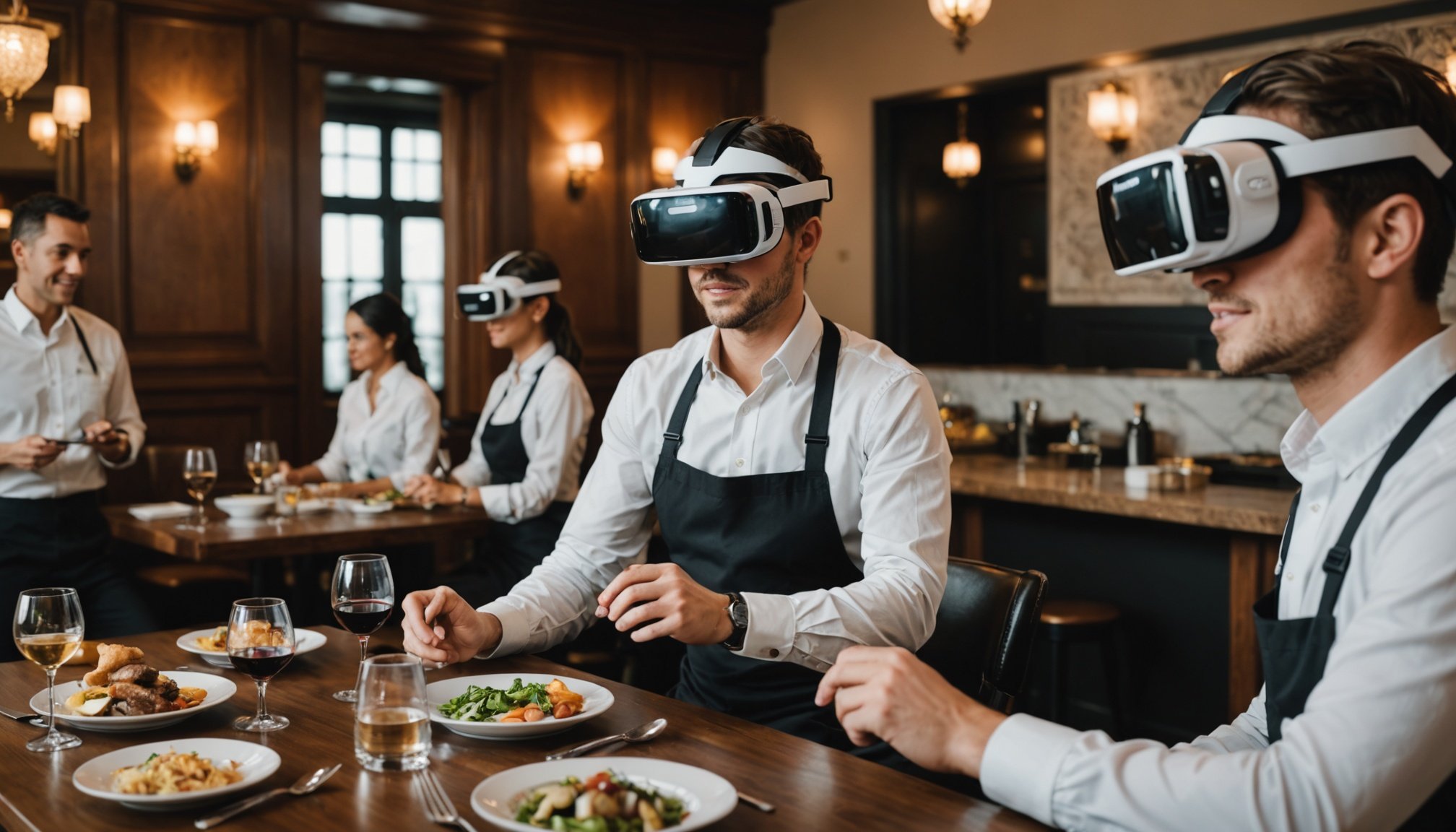Revolutionizing Fine Dining Staff Training with Virtual Reality: Elevate Learning Experiences Through Cutting-Edge Tech
In the ever-evolving landscape of the hospitality industry, particularly in fine dining, the need for innovative and effective staff training has never been more pressing. Traditional training methods, while effective in the past, are being surpassed by cutting-edge technologies that offer more immersive, engaging, and efficient learning experiences. One such technology that is revolutionizing the way restaurants train their staff is virtual reality (VR).
The Power of Virtual Reality in Training
Virtual reality is not just a novelty; it is a powerful tool that can transform the learning process for restaurant staff. Here’s how:
Also read : Maximizing Restaurant Retention: Crafting Top-Notch Loyalty Programs to Boost Customer Loyalty
Immersive Learning Experiences
VR provides an immersive environment where staff can practice and learn in a simulated real-world setting. This is particularly beneficial for training in high-pressure situations, such as managing a busy kitchen or handling complex customer service scenarios, without the risks associated with real-world mistakes.
- **Simulation of Real-World Scenarios**: Train staff in scenarios that mimic real-world challenges, such as a packed dining room or a kitchen during peak hours.
- **Interactive Training**: Engage staff with interactive modules that require them to make decisions and take actions in a virtual environment.
- **Repetition and Practice**: Allow staff to repeat training scenarios multiple times to reinforce learning and build confidence.
Enhanced Retention and Engagement
Studies have shown that VR training leads to higher retention rates compared to traditional methods. The interactive and engaging nature of VR keeps staff more focused and motivated.
Have you seen this : Enhancing Culinary Atmosphere: Expert Scent Marketing Techniques to Transform Dining Experiences
- **Engaging Storytelling**: Use VR to tell stories that illustrate key service standards, food safety protocols, or operational efficiency tips.
- **Gamification**: Incorporate elements of gamification to make training fun and competitive.
- **Real-Time Feedback**: Provide immediate feedback on performance, helping staff to correct mistakes and improve quickly.
Key Benefits for the Restaurant Industry
The integration of VR into staff training offers several key benefits that can significantly impact the restaurant industry.
Operational Efficiency
VR training can streamline operations by ensuring that staff are well-prepared and knowledgeable about their roles.
- **Reduced Errors**: Minimize errors in food preparation, service, and customer interactions by training staff in a controlled environment.
- **Improved Consistency**: Ensure consistent service and food quality across all shifts and locations.
- **Efficient Onboarding**: Speed up the onboarding process for new staff by providing them with comprehensive VR training.
Customer Satisfaction
Well-trained staff are crucial for delivering exceptional customer experiences. VR training can help in this regard by focusing on customer service skills.
- **Customer Service Skills**: Train staff to handle customer complaints, queries, and special requests effectively.
- **Personalized Service**: Teach staff how to provide personalized service by understanding customer preferences and needs.
- **Real-Time Scenarios**: Practice handling real-time customer service scenarios in a virtual environment.
Data-Driven Decision Making
VR training can be integrated with data analytics to provide insights into staff performance and training effectiveness.
| **Metric** | **Description** |
|
|----------------------------------------------------------------------------------|
| **Completion Rate** | Percentage of staff who complete the VR training modules. |
| **Performance Score** | Average score of staff in VR training scenarios. |
| **Feedback Ratings** | Staff feedback on the effectiveness and engagement of VR training. |
| **Error Reduction** | Reduction in errors post-VR training compared to pre-training. |
| **Customer Satisfaction** | Improvement in customer satisfaction scores post-VR training. |
Practical Implementation and Examples
Implementing VR training in a restaurant setting requires careful planning and execution. Here are some practical steps and examples:
Setting Up VR Training
To set up VR training, restaurants need to invest in VR hardware and software, as well as develop or acquire relevant training content.
- **Hardware Investment**: Purchase VR headsets and compatible computers or devices.
- **Content Development**: Create or purchase VR training modules that are specific to the restaurant industry.
- **Training Environment**: Designate a space for VR training where staff can practice without distractions.
Real-World Examples
Several restaurants and hospitality businesses are already leveraging VR for staff training.
- **AMPM Café and Bar**: As mentioned by Rajan Sethi and Deepika Sethi, Managing Directors of Bright Hospitality Pvt. Ltd., "Technology also plays a major role, from seamless reservations to innovations like augmented reality menus. While tech enhances convenience and engagement, it also streamlines operations to ensure consistency."[1]
- **Fonda Mexican**: Fonda Mexican has seen significant improvements in customer satisfaction and operational efficiency through tailored training programs, which could be further enhanced with VR training. For instance, "Fonda were very insistent that a generic program of training and assessment was not what they required. CHT provided training and assessment that was learner-centred and which supported lifelong learning."[2]
#### Expert Insights
Industry experts emphasize the importance of integrating technology, including VR, into staff training.
markdown
- Roop Partap Choudhary, ED of Noormahal Group: “Integrating technology can be tough for some restaurants. However, it’s a game-changer. Restaurant management systems simplify operations, enabling efficient reservations, order management, and payments. Digital menus and table-side tablets help guests make informed choices.”[1]
- Utsav Khaitan, Founder of Ditas: “Creating memorable dining experiences isn’t without its challenges. Rising costs, staff shortages, and the pressure to constantly innovate are major obstacles. Today’s diners expect more than just great food—they want a narrative, sustainability, and even entertainment.”[1]
### Overcoming Challenges and Ensuring Success
While VR training offers numerous benefits, there are also challenges to consider and strategies to ensure its successful implementation.
#### Addressing Cost and Accessibility
One of the primary challenges is the initial cost of investing in VR hardware and software.
- Cost-Effective Solutions: Look for cost-effective VR solutions or consider leasing options.
- Phased Implementation: Implement VR training in phases, starting with key areas such as customer service or kitchen operations.
#### Ensuring Staff Engagement
Ensuring that staff are engaged and motivated to use VR training is crucial.
- Training Sessions: Conduct regular training sessions to familiarize staff with VR technology.
- Feedback Mechanisms: Establish feedback mechanisms to understand staff preferences and areas for improvement.
- Incentives: Offer incentives for staff who complete VR training modules and demonstrate improved performance.
#### Balancing Traditional and VR Training
It’s important to strike a balance between traditional training methods and VR training.
- Blended Learning: Use a blended learning approach that combines traditional training with VR modules.
- Continuous Training: Ensure that VR training is part of a continuous training program, with regular updates and new modules.
### The Future of Fine Dining Staff Training
As technology continues to evolve, the future of fine dining staff training looks promising with VR at the forefront.
#### Predictive Ordering and AI Integration
Future VR training could be integrated with predictive ordering and AI to enhance operational efficiency and customer service.
- Predictive Ordering: Use AI to predict customer demand and generate automated orders, ensuring that necessary supplies are always on hand[4].
- AI-Driven Analytics: Use AI to analyze data from VR training to provide insights into staff performance and training effectiveness.
#### Augmented Reality and Virtual Reality Convergence
The convergence of augmented reality (AR) and VR could further enhance the learning experience.
- AR Menus: Use AR to create interactive menus that provide customers with detailed information about dishes, enhancing the dining experience[1].
- VR Training Scenarios: Develop VR training scenarios that incorporate AR elements to make the training more interactive and realistic.
“`
The integration of virtual reality into fine dining staff training is a game-changer for the restaurant industry. It offers immersive learning experiences, enhances operational efficiency, and improves customer satisfaction. By understanding the benefits, practical implementation steps, and strategies to overcome challenges, restaurants can leverage VR to elevate their staff training and stay ahead in the competitive hospitality industry.
In the words of Saurav Mishra, Owner of Hilly Billy Café, “Vibes can be created by the simplest of things. It’s all about creating a culture. It can be the feeling while you enter a specific restaurant to the staffs greeting you. Vibes are generally very essential as it helps customers to decide whether they want to continue dining out with your restaurant or not.”[1]
As the hospitality industry continues to evolve, embracing cutting-edge technologies like VR will be key to delivering exceptional dining experiences and ensuring long-term success.











